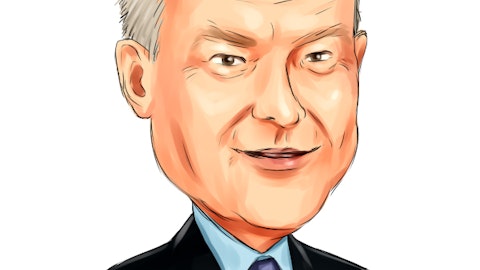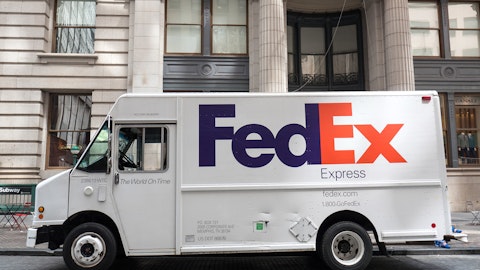Operator: Thank you. The next question is coming from David Vernon of Bernstein. Please go ahead.
David Vernon: Hey. Good afternoon. Thanks for fitting me in here. The rate or month per mile on your truckload slide six there, being down 28%, that’s kind of well ahead of some of the benchmark indices that you follow from CAS and some of the other third-party stuff. Can you give us a sense for how much of the book is getting repriced at this level right now? And what does that mean kind of from a go-forward perspective? Are we going to be stabilizing at these levels? Or is there still some more maybe pain to take as this truck cycle reaches its trough?
Mike Zechmeister: Yes, we re-price our contracts all throughout the year; tend to be a little bit heavier in Q4 and Q1. So call it, 60% gets repriced in Q4 and Q1 and the other 40% in Q3 — in Q2 and Q3. So you kind of think about it that way. I think what was interesting when we’re looking at price per mile and cost per mile this quarter in comparison to last year was just how much the decline was on a percentage basis. So, we were — as we kind of pointed out, we’re down 27.5% on a rate per mile and 28.5% on a cost per mile. And so when you look at year-over-year, those are the largest that we’ve seen in over a decade. Sequentially, it was the fifth straight quarter that price per mile came down and also the fifth straight quarter that cost per mile came down, and that’s after the run-up that we saw for seven, eight quarters prior to that. So that’s the way we’re seeing it play out.
David Vernon: Okay. And then maybe just as a quick follow-up. You don’t give us some of the same detail in terms of the buy and sell rates for the business and understand different modes, more complicated. But I guess as you think about the rate at which your customer rates are coming down and correcting with the — available indices we will be looking at, is that spreads, also widening a little bit, or are we getting to the point where your Forwarding business has caught up to where sort of market rates are today.
Mike Zechmeister: Yes. Like we kind of said that business gets re-bid, repriced here, and we’ve been going through that. And hard to say where you’ve hit bottom, that — especially on the ocean side, you have a capacity issue there that’s got to play out in terms of there’s certainly, capacity coming into the market there. And there’s a little bit coming out, but not as much as coming in. And so how that plays out is yet to be seen, particularly considering the macro environment and what’s there in demand. The market is looking at the possibility of a recession here for the remainder of the year. Obviously, that impacts demand. And so, that supply/demand kind of play in the ocean business is a little bit harder to call at this point in how pricing will get reflected there.
David Vernon: And on the air side?
Mike Zechmeister: Yes, similar dynamics on the air side. I wouldn’t say much different there except for the capacity situation is obviously a little bit different. But it will key off the macro demand environment, and that, I think, is yet to be seen–
David Vernon: All right. Thanks for the time guys.
Mike Zechmeister: Thank you.
Operator: Thank you. We’re showing time for one last question today. The final question is coming from Ken Hoexter of Bank of America. Please go ahead.
Ken Hoexter: Great. Thanks for squeezing me in. Scott, maybe just — how do you think about the core brokerage? I know you had some questions in the prepared remarks on the timing of the CEO. But should C.H. be moving to more automation and less people intensive? I guess I want to understand your thoughts on the design for the company and where you think it’s headed.
Scott Anderson: Yes, Ken, great question. I think it’s a combination of both. I think the technology amplifies the expertise of our people and our ability for our people to drive continued growth and drive operating leverage for the business and grow without adding headcount is one of the key things to what we’re doing. So, to me, we’re on a path to have multiple wins win for our customers, win for our carriers and a win for our people when we do this the right way.
Ken Hoexter: But I guess to take it a step further, do we see a reshaping of it, where we’re seeing big layoffs to shift the dynamic of that balance in the near-term?
Scott Anderson: No, I think one of the things that Robinson is so strong at is our commercial engine. And I think one of the things we have to do is leverage the technology. We’ve seen that in terms of how we compete against our technology competitors. So, this is an additive game, a one plus one equals four or five. And one of the things Arun is doing and part of our cost reduction strategy here is also to drive costs out of areas and take complexity out of the organization to drive it towards the right things that grow the business and grow margin.
Ken Hoexter: That’s helpful to understand. And then just a follow-up, on the capacity exits, I guess there are a lot of peers that are focused on — you mentioned the digital peers focused on positive and profitable volume growth in taking share. Maybe can you just spend a minute talking about the competitive dynamic in the market right now?
Mike Zechmeister: Yes, I’ll make a couple of comments there, Ken. So I mentioned that the competitiveness seems to have heated up, particularly on the brokerage side here. And we could certainly go out and get more volume, but we’re committed to getting profitable volume. And so we are not interested in getting into any kind of competitive situation that would lead us to issues with negative loads or chasing that kind of volume. So, we’ve been pretty disciplined there. We’ve got really good pricing engines. We feel like we’ve got great understanding in the market. And so we feel like we can compete pretty effectively there with our data advantage and our people and connectivity to the customers in a way that will continue to be able to make strides both on a market share gain standpoint and against our margin targets.
Ken Hoexter: Great. Scott, Mike thanks for the time. Appreciate it.
Mike Zechmeister: Thank you.
Operator: Thank you. At this time, I’d like to turn the floor back over to Mr. Ives for closing comments.
Chuck Ives: Yes. Thank you, everyone, for joining us today. That concludes today’s earnings call, and we look forward to talking to you again. Have a great evening.
Operator: Ladies and gentlemen, thank you for your participation. This concludes today’s event. You may disconnect your lines or log off the website at this time and enjoy the rest of your day.
Follow C. H. Robinson Worldwide Inc. (NASDAQ:CHRW)
Follow C. H. Robinson Worldwide Inc. (NASDAQ:CHRW)
Receive real-time insider trading and news alerts





